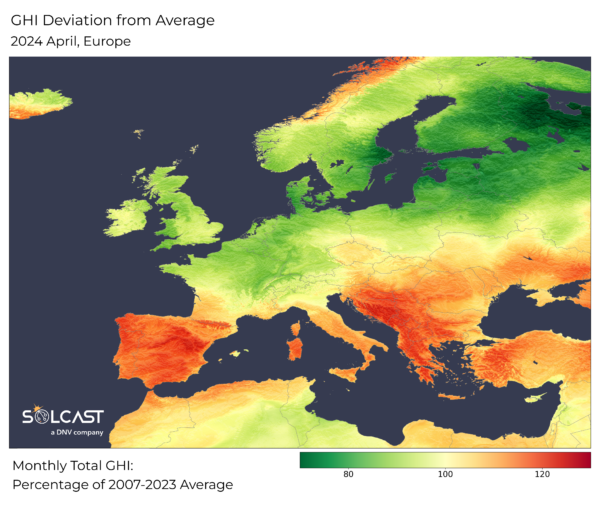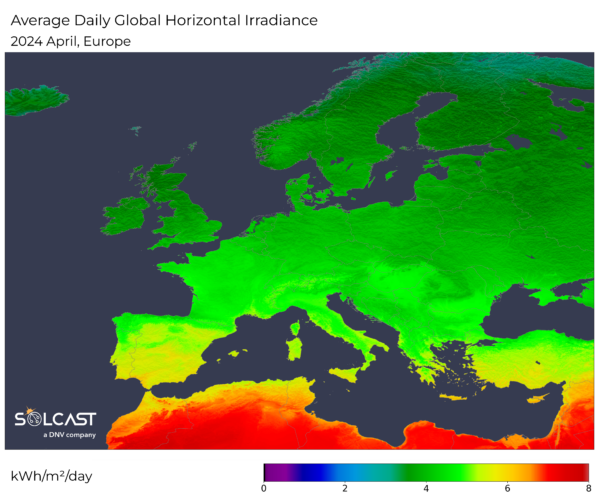April's weather in Europe presented a north-south divide impacting solar generation across the continent. High pressure systems over the Mediterranean meant sunnier than normal conditions in Southern Europe, benefitting PV output. Successive low pressure systems in the north resulted in cloudier weather affecting solar generation. Around the Mediterranean, there were a few dust transport events in April, where airborne dust will have impacted irradiance, and soiling may have impacted generation, but these 1-2 day events are not visible in the monthly averages.
Sunnier conditions were enjoyed in the Iberian Peninsula and around the Mediterranean and the Black Sea, with irradiance levels reaching up to 15-20% above long term April averages. Solar assets in Bosnia and Herzegovina, Croatia, Turkey, Greece, Spain, Portugal, and parts of Italy benefited from these conditions. The increase in irradiance level was attributed to clear skies and settled weather brought on by higher-than-usual pressure for this time of the year.

In contrast, April was a cloudy and rainy month for northern Europe resulting in decreased PV generation. This cloud was driven by successive low pressure systems across the region from the North Sea, which explains the 15-20% below average irradiance in Baltic States, Finland, Sweden, Denmark, Germany, France (excluding the south), the Benelux Countries, the United Kingdom, and Switzerland. The Baltic States and Finland were hit hardest, with irradiance being 20% below normal, which equates to an average of only 3kWh/day of irradiance.

Popular content
Contrary to the overall irradiance level in northern Europe, the northern parts of Norway received 10% above normal irradiance. This can be attributed to the low pressure systems moving further south, which reduced the usual cloudiness in the far northern regions. However, the likely solar production impact here is low, as irradiance in these northern latitudes is only 3.0-3.5kWh/day, and the regions are sparsely populated.
There were several instances of Saharan dust transport into Europe during April. These occurred in early April across Spain, and 23/24th April in Greece and the Ukraine, causing local irradiance drops of up to 25% of daily irradiance. Due to the short duration of these events, they are not visible in the monthly average irradiance, but dust soiling from such events can have longer-lasting impacts on PV generation.
Solcast produces these figures by tracking clouds and aerosols at 1-2km resolution globally, using satellite data and proprietary AI/ML algorithms. This data is used to drive irradiance models, enabling Solcast to calculate irradiance at high resolution, with typical bias of less than 2%, and also cloud-tracking forecasts. This data is used by more than 300 companies managing over 150GW of solar assets globally.
The views and opinions expressed in this article are the author’s own, and do not necessarily reflect those held by pv magazine.
This content is protected by copyright and may not be reused. If you want to cooperate with us and would like to reuse some of our content, please contact: editors@pv-magazine.com.


By submitting this form you agree to pv magazine using your data for the purposes of publishing your comment.
Your personal data will only be disclosed or otherwise transmitted to third parties for the purposes of spam filtering or if this is necessary for technical maintenance of the website. Any other transfer to third parties will not take place unless this is justified on the basis of applicable data protection regulations or if pv magazine is legally obliged to do so.
You may revoke this consent at any time with effect for the future, in which case your personal data will be deleted immediately. Otherwise, your data will be deleted if pv magazine has processed your request or the purpose of data storage is fulfilled.
Further information on data privacy can be found in our Data Protection Policy.